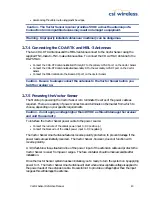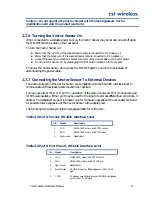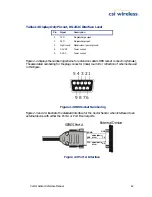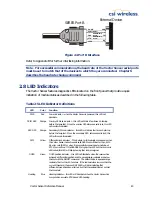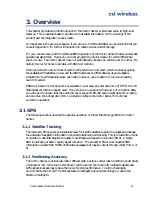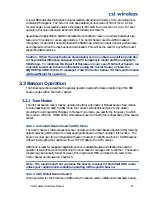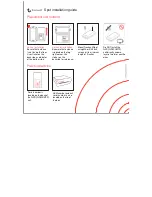
Vector Sensor Reference Manual
54
4.
Operation
This chapter provides a brief overview to the operations of the Vector Sensor and provides an
introduction its the input / output interface.
4.1
Powering the Vector Sensor
As described in Chapter 2, Installation, the Vector Sensor is powered by connecting the red and
black power leads of the power cable to an 8 to 40 VDC power source. You will need to press
the ON/OFF switch on the back panel of the Vector Sensor in order to turn the receiver system
on or off once connected to a suitable power source. Once powered, the Vector Sensor will
proceed through an internal start-up sequence, however it will be ready to communicate within a
few seconds.
When installed such that the Antenna Array has an unobstructed view of the sky, the Vector
Sensor will provide a position within approximately 60 seconds from startup. SBAS lock requires
approximately 30 seconds to acquire from startup.
Note - It can take up to 5 minutes for a full ionospheric map to be received from
SBAS. Optimum accuracy will be obtained once the Vector Sensor is processing
corrected positions using complete ionospheric information.
4.2
Communicating with the Vector Sensor
The Vector Sensor features dual serial ports that may be configured independently from each
other (Port A and B). The ports may be configured for a mixture of NMEA 0183, binary, and
RTCM SC-104 data. The usual data output is only required NMEA data messages.
Note - If you require different data types to be output from the Vector Sensor
simultaneously you may to separate the data to the two different serial ports if this is
more convenient.
4.2.1
NMEA 0183 Interface
NMEA 0183 is a communications standard established by the National Marine Electronics
Association (NMEA) and provides data definitions for a variety of navigation and related
equipment. Such instruments supported include gyrocompasses, Loran receivers, echo sounders,
GPS receivers, and more. NMEA functionality is virtually standard on all GPS equipment available.
NMEA has an ASCII character format that allows you to read the data via terminal software on the
receiving device (if possible). Some example NMEA data from the Vector Sensor follows.
$GPGGA,144049.0,5100.1325,N,11402.2729,W,1,07,1.0,1027.4,M,0,M,,0100*61
$GPVTG,308.88,T,308.88,M,0.04,N,0.08,K*42
$GPGSV,3,1,10,02,73,087,54,04,00,172,39,07,66,202,54,08,23,147,48*79
$GPGSV,3,2,10,09,23,308,54,11,26,055,54,15,00,017,45,21,02,353,45*78
$GPGSV,3,3,10,26,29,257,51,27,10,147,45,,,,,,,,*74

